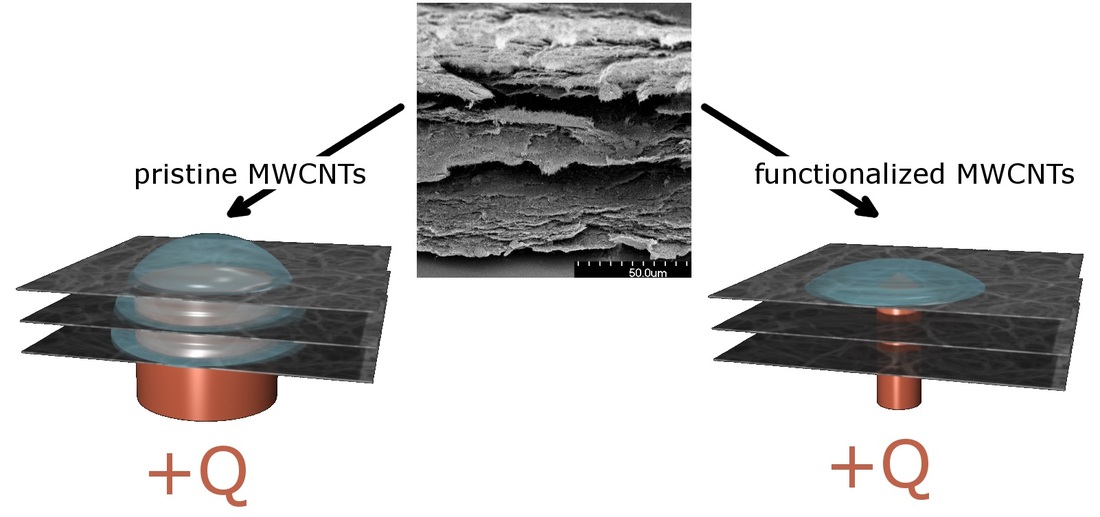|
It's been a long time since I added new content to this blog, sorry about that. We've had an active Spring and published several papers together with co-author groups, see the publication list for details please. Now I'm happy to report on yet another Carbon paper accepted from our group. Gábor Kozma and other members of our team have successfully used multiwall carbon nanotubes to validate the Burgio-Rojac energy model of planetary ball milling. The paper "Experimental validation of the Burgio-Rojac model of planetary ball milling by the length control of multiwall carbon nanotubes" was accepted for publication today. Congratulations to all co-authors, keep up the good work guys!
0 Comments
I have splendid news to conclude this weekend's blogging. Our paper "Surface pinning explains the low heat transfer coefficient
between water and a carbon nanotube film" was accepted for publication in Carbon a few days ago. The paper is about a very peculiar phenomenon observed by Betty: the heat transfer coefficient between carboxy-functionalied MWCNT buckypaper and a sessile water droplet is less than half of that between unfunctionalized MWCNT buckypaper and water. This is a major surprise at first glance because intuition suggests that the more hydrophilic buckypaper should be the better performer. We were able to explain the phenomenon on the basis of the layered structure of buckypaper and the localization of the droplet on the top of the buckypaper. I am very proud of this paper, a truly joint effort by all co-authors: Erzsébet-Sára Bogya has made the measurements and the data analysis and Botond Szilágyi developed the theoretical model and run the fitting and I initiated the discussion and polished their manuscript a bit. Task distribution worked very well. I am thankful to both co-authors and sincerely hope to continue working together in this fashion.
Last December was a fruitful month for papers. Three papers written by collaborators of our group were accepted for publication:
Dear Readers, this entry is to wish all of you a happy, healthy and prosperous 2016! I hope that you'll keep checking this blog for updates and I also hope that I'll be able to provide you with interesting updates – it's gonna be a team effort, really :)
First trivia for the new year: did you know that 2016 is the Official, Dedicated Year of Pulses? Bet you didn't :) Check out the homepage, eat healthy, read good books and stay tuned for science news! Happy New Year! What a nice way to start the festive season! :) Our paper "Environmentally benign synthesis methods of zero valent iron nanoparticles" has been accepted for publication in ACS Sustainable Chemistry & Engineering today. The paper is based mostly on the work of Gábor Kozma and Andrea Rónavári, congratulations guys! This paper will be published in a special issue of the journal celebrating Prof. Rajender Varma, a former plenary speaker of our SIWAN conference series and a hugely motivating scientist.
I am pleased to report that the report on the first 3 years of our Lendület group was accepted by the Hungarian Academy of Sciences. Lendület projects were all evaluated on a 4-level scale, our group received the highest possible evaluation ("excellent", meaning that we were doing significantly better than the average performance of the research units in the HAS network). This is the joint success of all group members and our collaborators, it would be impossible to achieve without your support and motivation. So: a big "thank you" goes to all who supported us in any way. Thank you indeed!
Good news here: our paper titled "Functionalized Boron Nitride Porous Solids" was accepted for publication in RSC Advances. This is a nice example of international cooperation with Prof. Ajayan's group at Rice University. Thank you to all involved, especially to Parambath Sudeep who was the operative coordinator of this research.
I'm pleased to report about a new paper that was accepted for publication in CrystEngComm last week. The paper "A simple method to control the formation of biomimetic cerium phosphate architectures," was written by Péter Pusztai and serves as a nice example of successful collaboration between the group lead by Profs. Agate Tóth and Dezső Horváth and our own people at the Dept. of Applied and Environmental Chemistry. Keep up the good work guys!
This year the conference organized by the Hungarian Technical Scientific Society of Transylvania was held at Csíksomlyó (Romania), near the thousand-years old Hungarian border and the Gyímes mountains. The main objective of the symposium is to ensure an annually meeting opportunity for Hungarian scientist to present and discuss the latest issues in their field of research. The plenary lecture topics gave us a general idea about amphiphilic polymer networks, gels, symmetry of reaction mechanism and research directions in bioengineering. From the MTA-SZTE "Lendület" Porous Nanocomposites Research Group Erzsébet Sára Bogya held a presentation about recent results obtained in the topic of sessile droplet evaporation from nano-porous materials. The talk summarized the preparation and characterization of carbon nanotube-titanate nanowire porous composite mats, their evaporation/temperature profile characteristics variation in function of TiONW content and water droplet evaporation thermographic monitoring. Blog entry written by Dr. Erzsébet-Sára Bogya.
I had the pleasure of meeting two very nice colleagues in the second half of September at Szeged. Both are experts in theory and modeling and I have very high hopes of collaborating with them in the future. We plan to investigate wetting and spreading phenomena with Prof. Zoltán Néda (Babes-Bolyai University, Romania) and the electrical and mechanical properties of buckypapers with Dr. Amit Rawal (Indian Institute of Technology, Delhi).
|
AuthorÁkos Kukovecz is associate professor of chemistry and Head of the MTA-SZTE Lendület Porous Nanocomposites Research Group. He works at Szeged, Hungary. Archives
July 2017
Categories
All
|




 RSS Feed
RSS Feed
